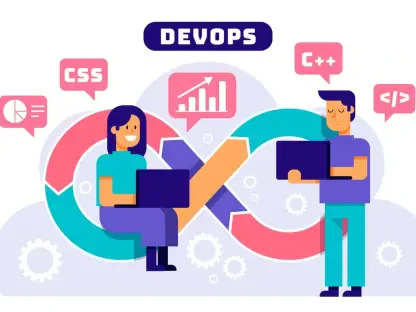Unveiling the Threat Landscape of Npm Supply Chain Attacks
Imagine a scenario where a single line of code, unknowingly pulled from a trusted open-source repository, compromises an entire enterprise system, exposing thousands of developer credentials in mere hours. This is not a hypothetical situation but a stark reality within the npm ecosystem, where supply chain attacks have emerged as a formidable threat to software development environments. Recent incidents have revealed how attackers exploit the trust developers place in platforms like npm, targeting enterprise systems with devastating precision.
These attacks are not isolated events but part of a growing trend that capitalizes on the widespread reliance on open-source software. With millions of developers using npm daily to build and deploy applications, the potential for large-scale data breaches and credential theft looms large. The sophistication of these threats, often involving advanced techniques, underscores a critical need for awareness and robust defenses to protect sensitive information.
This guide delves into the nature of npm supply chain attacks, exploring their mechanisms, real-world impacts, and actionable strategies for mitigation. By understanding how these threats operate and their consequences for both individual developers and large organizations, a clearer path to safeguarding development pipelines emerges. The focus here is on equipping stakeholders with the knowledge to navigate this evolving danger.
Why Npm Supply Chain Attacks Demand Immediate Attention
The npm registry serves as a cornerstone of modern software development, hosting millions of packages that developers integrate into projects without a second thought. This inherent trust, while fostering efficiency, creates a vulnerability that attackers exploit with alarming frequency. Supply chain attacks through npm can infiltrate enterprise systems at their core, bypassing traditional security measures designed for external threats.
Addressing these risks is paramount because the consequences extend far beyond a single compromised machine. A breach in one developer’s environment can ripple through continuous integration and continuous deployment (CI/CD) pipelines, exposing entire organizational infrastructures to data theft or unauthorized access. Proactive measures are essential to prevent such cascading failures and maintain the integrity of development workflows.
Moreover, heightened awareness and timely action can significantly enhance security postures. By recognizing the potential for malicious packages to infiltrate trusted repositories, developers and IT teams can implement safeguards that protect sensitive credentials and prevent costly breaches. This vigilance is not just a technical necessity but a strategic imperative for any organization relying on open-source tools.
Dissecting the Tactics and Consequences of Npm Supply Chain Attacks
Supply chain attacks on npm employ sophisticated methods to deceive developers and infiltrate systems. Techniques such as typosquatting—where malicious packages mimic legitimate ones with subtle name variations—alongside AI-driven reconnaissance and heavy code obfuscation, are commonly used to target unsuspecting users. These approaches exploit the fast-paced nature of development, where quick package installations often occur without thorough vetting.
The impacts of these attacks are profound, often resulting in the theft of critical credentials and exposure of sensitive data. Real-world incidents have shown how attackers can harvest GitHub tokens, cloud access keys, and personal information, uploading them to publicly accessible repositories for further exploitation. Such breaches not only jeopardize individual developers but also threaten the security of entire enterprises dependent on interconnected systems.
Understanding these mechanisms and their fallout is crucial for building effective defenses. By examining specific cases, the scale and stealth of these threats become evident, highlighting the urgency of adopting robust security practices. The following sections break down notable examples that illustrate the depth of this challenge and the innovative ways attackers target development environments.
Exploitation Through Trusted Tools and Workflows
Attackers often leverage tools and workflows that developers trust implicitly, such as GitHub Actions and popular extensions for coding platforms. These components, integral to streamlined development, become entry points when vulnerabilities are exploited. A notable case involved the Nx build system, where a flaw in a GitHub Actions workflow allowed malicious code injection through unsanitized input, granting attackers elevated permissions.
This exploitation method reveals a systemic issue in how development pipelines are secured. Tools designed to enhance productivity can become liabilities if not configured with stringent safeguards. The abuse of trusted systems to execute arbitrary commands demonstrates the need for meticulous scrutiny of every element in the development chain, from source code to deployment scripts.
Such incidents emphasize that security must be embedded at every stage of the software lifecycle. Developers and organizations cannot afford to assume the safety of widely used tools without verifying their configurations. Addressing these gaps is a critical step in preventing attackers from turning trusted workflows into vectors for compromise.
Case Study: Nx Build System Breach
A striking example of exploitation occurred with the Nx build system on August 26 of this year, where attackers compromised core components across multiple versions. This breach led to the theft of over 1,000 valid GitHub tokens and approximately 20,000 files, all of which were uploaded to attacker-controlled repositories. The scale of this incident illustrates how a single vulnerability can expose vast amounts of sensitive data.
The attack exploited a flaw in pull request handling, using unsanitized titles to inject malicious code with high-level access. This allowed the extraction of critical assets, including cloud credentials and environment variables, from developer machines and build pipelines. It serves as a stark reminder of the cascading effects a targeted supply chain attack can have on enterprise security.
Stealth and Sophistication in Malicious Packages
Beyond exploiting tools, attackers craft malicious packages with advanced obfuscation to evade detection. These packages often target specific user demographics, embedding code with multiple layers of concealment to steal data like passwords or cryptocurrency wallet details. The stealth of these attacks lies in their ability to blend into the npm ecosystem, appearing benign until activated.
Such tactics are particularly dangerous because they bypass conventional security scans that fail to penetrate deeply obfuscated code. By focusing on niche user groups or specific operating environments, attackers maximize the impact of their data theft while minimizing the likelihood of early discovery. This calculated approach underscores the evolving cunning of cyber threats in open-source spaces.
The challenge lies in detecting these threats before they cause harm, as their sophisticated design often delays identification until significant damage is done. Security teams must adapt by employing advanced scanning tools capable of dissecting complex code structures. Staying ahead of these stealthy attacks requires constant innovation in detection methodologies.
Case Study: React Package Malware Campaign
A separate incident involved eight malicious React packages identified within the npm registry, specifically targeting Windows Chrome users. These packages employed over 70 layers of obfuscation, concealing code that extracted sensitive browser data, including credit card information and cookies. The precision of this campaign highlights the tailored nature of modern supply chain threats.
The malware’s design included evasion techniques such as bypassing file locks and impersonating system processes to avoid scrutiny. This level of sophistication allowed attackers to harvest personal data while remaining undetected for extended periods. It reveals how attackers adapt to specific environments to maximize their illicit gains.
Safeguarding Against Npm Supply Chain Attacks: Essential Strategies
The evolving threat of npm supply chain attacks necessitates a comprehensive approach to security that spans immediate actions and long-term planning. Developers and enterprises must prioritize strategies that address both the detection of malicious packages and the mitigation of breaches when they occur. This dual focus is vital for maintaining trust in open-source ecosystems.
Immediate steps include rotating credentials potentially exposed in a breach, such as GitHub tokens and API keys, and conducting thorough system reviews to identify lingering threats. Additionally, adopting automated scanning tools to scrutinize dependencies for suspicious behavior can prevent the integration of compromised packages. These measures offer a rapid response to minimize damage from known attacks.
For sustained protection, stricter security policies around third-party software adoption are essential, alongside ongoing training for developers to recognize potential risks. Individual coders, enterprise IT teams, and security professionals all stand to benefit from these practices, though the persistence of local threats requires continuous vigilance. Before integrating new tools or packages, a cautious evaluation of their origins and update histories remains a critical consideration.
Reflecting on the Path Forward
Looking back, the wave of npm supply chain attacks that struck critical systems like the Nx build system and React packages earlier this year exposed significant vulnerabilities in the trust placed in open-source repositories. The sophistication of these breaches, marked by AI-driven tactics and intricate obfuscation, challenged existing security frameworks and revealed the urgent need for enhanced protections.
Moving ahead, the focus must shift toward integrating advanced automated tools that provide deep visibility into software dependencies, ensuring threats are identified before they manifest. Enterprises should also foster a culture of security awareness, encouraging developers to question the integrity of every package they use. By investing in these proactive solutions, the development community can build a more resilient defense against future attacks.
Beyond immediate fixes, collaboration across the industry to share threat intelligence and standardize security protocols offers a promising avenue for reducing systemic risks. Establishing robust guidelines for package verification and maintaining an active dialogue on emerging threats will empower stakeholders to stay one step ahead. This collective effort is the key to securing the software supply chain for years to come.









